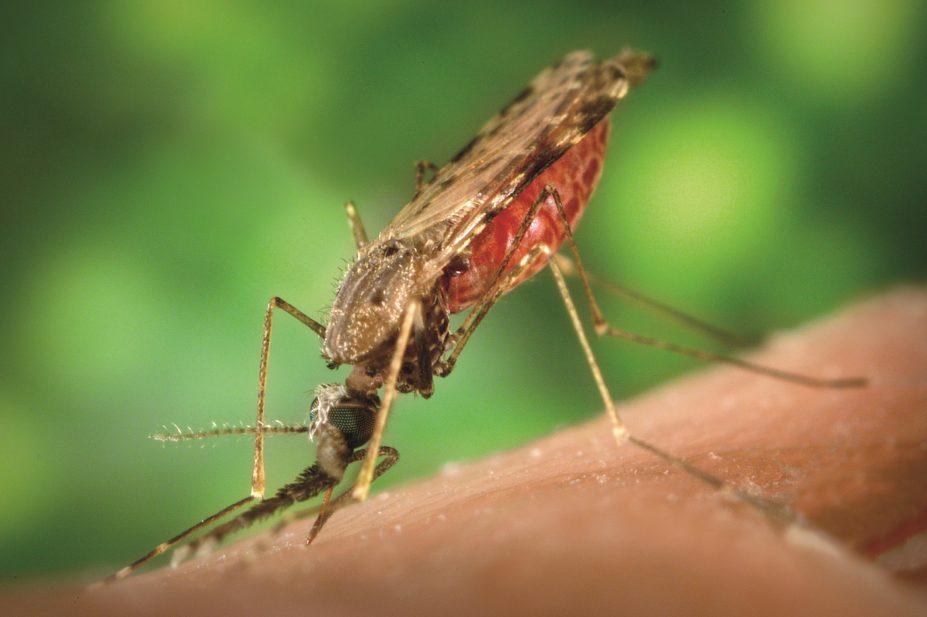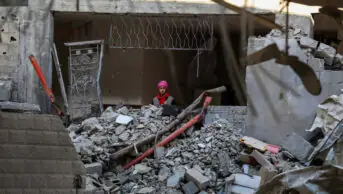
Centers for Disease Control and Prevention / Wikimedia Commons
The first candidate malaria vaccine to reach phase III clinical trials is not as effective at protecting young African children against the disease as was hoped, according to the results of the RTS,S clinical trial published in The Lancet
[1]
on 24 April 2015.
Early results published in 2014 found that the recombinant protein vaccine RTS,S/AS01 was more effective in children than infants, reducing malaria cases in children by almost a half and by just over a quarter in infants at 18 months after vaccination[2]
. The latest results show that the effectiveness of the vaccine wanes over time, although this can be attenuated by a booster dose to reduce a third of cases in children at four years from vaccination.
Despite the setback, the researchers who conducted the clinical trial say the vaccine is still worth deploying because millions of children could benefit from vaccination in areas of high transmission.
More than 15,000 infants (aged 6–12 weeks) and children (5–17 months) in seven sub-Saharan African countries (Burkina Faso, Gabon, Ghana, Kenya, Malawi, Mozambique and Tanzania) were enrolled between March 2009 and January 2011 in the trial, which GlaxoSmithKline conducted in partnership with the PATH Malaria Vaccine Initiative (MVI) with funding from the Bill and Melinda Gates Foundation.
The infants and children were randomised in groups to receive three doses of RTS,S/AS01 at months 0, 1, and 2 and a booster dose at month 20; three doses of RTS,S/AS01 and a dose of a comparator vaccine at month 20 to act as a control; or four doses of the comparator vaccine at months 0, 1, 2, and 20. The children were followed for a median of 48 months and the infants for a median of 38 months after the first dose.
The number of clinical episodes of malaria was reduced by just over a third (36%) at four years in children who received three doses of RTS,S/AS01 plus a booster, and by 28% in children who did not receive the booster. Only children who received the booster dose benefitted from significant protection against severe malaria, with a 32% reduction in severe cases, and a 35% fall in malaria-associated hospitalisations.
The vaccine was less effective in infants. Clinical episodes of malaria were reduced by 26% over three years follow-up in infants who received three doses of RTS,S/AS01 plus a booster, and by 18% in infants who did not receive the booster, but there was no significant protection against severe disease.
In 2014, initial phase III results at 18 months had reported efficacy for the vaccine of about 46% against clinical malaria in children and around 27% among young infants.
Despite the falling efficacy over time, there is still a clear benefit from RTS,S/AS01
Brian Greenwood, a researcher in tropical medicine at the London School of Hygiene and Tropical Medicine, and involved in the trial, says: “Despite the falling efficacy over time, there is still a clear benefit from RTS,S/AS01. An average 1,363 cases of clinical malaria were prevented over 4 years of follow-up for every 1,000 children vaccinated, and 1,774 cases in those who also received a booster shot. Over 3 years of follow-up, an average 558 cases were averted for every 1,000 infants vaccinated, and 983 cases in those also given a booster dose.
“Given that there were an estimated 198 million malaria cases in 2013, this level of efficacy potentially translates into millions of cases of malaria in children being prevented.”
But Adrian Hill, director of the Jenner Institute at the University of Oxford, says the assertion that the vaccine may be worth deploying in some settings because it prevented large numbers of uncomplicated cases was controversial. “There was no impact on malaria mortality and no significant effect on severe malaria: non-significant reductions of just 1% and 10% were observed in the children and infants studied over the full trial period using a three dose regimen. This is clearly lower than the efficacy of impregnated bed nets,” he says.
New evidence of a rebound in malaria susceptibility after vaccination was “worrying”, he adds. “After 20 months, vaccinated children who were not boosted showed an increased risk of severe malaria over the next 27 months compared with non-vaccinated controls.”
It should be possible to make the vaccine more effective in some settings with improved scheduling, but that will probably increase delivery costs substantially
However, he concedes: “It should be possible to make the vaccine more effective in some settings with improved scheduling, but that will probably increase delivery costs substantially.”
The clinical trial showed that meningitis occurred more frequently in children given RTS,S/AS01 (11 children in the group who received the booster dose and 10 in those who did not) than in those given the control vaccine (1 child). Convulsions following vaccination, although uncommon, also occurred more frequently in children who received RTS,S/AS01 than in controls. The incidence of other serious adverse events was similar in all groups.
The safety and efficacy of RTS,S/AS01 is being reviewed by the European Medicines Agency’s (EMA’s) Committee for Medicinal Products for Human Use (CHMP) under an article 58 procedure, which allows the CHMP to give opinions, in co-operation with the World Health Organization (WHO), on medicinal products for human use that are intended exclusively for markets outside of the EU. An opinion is expected in the second half of 2015, says an EMA spokesperson.
If a positive opinion is obtained and the vaccine is pre-qualified by the WHO, malaria endemic countries will need to decide whether to license and use the vaccine and, if so, what schedule to use, say the researchers.
GSK also committed to evaluate any possibility that would promote reducing the cost of manufacturing
The price of the vaccine has yet to be set, but a spokesperson for GSK says: “In January 2010, GSK committed to setting a price that covers costs of manufacturing the vaccine and a small return of 5% to be reinvested in R&D for next generation malaria vaccines, or for other treatments for diseases of the developing world. GSK also committed to evaluate any possibility that would promote reducing the cost of manufacturing.”
In most African countries standard childhood vaccines are provided to children for free, often through funding mechanisms such as the Global Alliance for Vaccines and Immunisation (Gavi) and limited contributions from the countries, she adds. Gavi has said it will consider funding the RTS,S/AS01 candidate vaccine if it is recommended by the WHO.
In an accompanying commentary[3]
, Vasee S Moorthy and Jean-Marie Okwo-Bele at the department of immunization, vaccines and biologicals at the WHO, say the donor community would need to co-ordinate any financing for the vaccine carefully, should it reach that stage.
“In particular, funding must not be redirected away from meeting adequate access to artemisinin-combination treatments, rapid diagnostic tests, long-lasting insecticidal nets, and other malaria control measures already in place in some settings, and financial resources might be better raised through the Gavi Alliance, if their board chooses to support such a role,” they add.
In April 2015, the WHO issued updated Guidelines for the Treatment of Malaria[4]
. For uncomplicated malaria cases, WHO recommends the use of artemisinin-based combination therapies (ACTs) and diagnostic testing for all suspected malaria cases to ensure that malaria drugs are used only by those who have the disease.
WHO also recommends that the most vulnerable groups in malaria-endemic areas of sub-Saharan Africa — pregnant women, children under 5, and infants — receive preventive treatment to reduce the risk of malaria infection. While preventive treatments are highly cost-effective, coverage remains low and needs to be significantly scaled up, WHO says.
WHO has developed a new global malaria strategy for 2016–2030 that will be reviewed by the World Health Assembly in May 2015. This sets a target of reducing the disease burden of malaria by 40% by 2020, and at least 90% by 2030 plus eliminating the disease in at least 35 new countries. The strategy provides a comprehensive framework for countries to develop tailored programmes that will sustain and accelerate progress towards malaria elimination.
References
[1] RTS,S Clinical Trials Partnership. Efficacy and safety of RTS,S/AS01 malaria vaccine with or without a booster dose in infants and children in Africa: final results of a phase 3, individually randomised, controlled trial. The Lancet 2015; doi.org/10.1016/S0140-6736(15)60721-8.
[2] The RTS,S Clinical Trials Partnership. Efficacy and safety of the RTS,S/AS01 malaria vaccine during 18 months after vaccination: a phase 3 randomized, controlled trial in children and young infants at 11 African sites. PLOS 2014; DOI: 10.1371/journal.pmed.1001685
[3] Moorthy, VS & Okwo-Bele JM, Final results from a pivotal phase 3 malaria vaccine trial, The Lancet (23 April 2015) DOI: http://dx.doi.org/10.1016/S0140-6736(15)60767-X
[4] WHO. Guidelines for the treatment of malaria. Third edition, April 2015.

